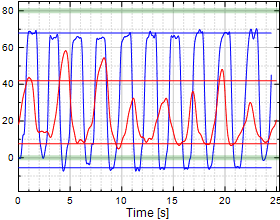Interpretation of Statistical Analysis
Reporting example
Consider the following example for Finger MP Flexion/Extension.
|
Chart Example:
Finger MP Flexion/Extension
|

|
|
|
Table Example:
Finger MP Flexion/Extension (F/E)
|
|
|
|
Explanation
This table can be interpreted as follows. Check with the chart to make sure
the results are consistent.
| # |
Description |
| 5. |
Coefficient of Variation (COV) is defined as = "standard deviation /
mean". Just by looking at the above equestion you'll see that the COV will
get very large when the mean gets very small because it's in the
denominator. This causes a significant bias. And it is dependent on how you
happen to choose your coordinate system. We calculated it, put it in the
reports, and studied the results. Then we rejected them and removed them. They
are not a good measure of variability.
Instead we are reporting Trial Consistency which is defined as "standard
deviation / range of motion". It lives on line 5.
We believe this is a much
more reliable measure to compare variability between different trials. |
| 10. |
"Closeness" of left to right is included. It is expressed as hypothesis
H1 with its result and corresponding probability in lines 10 (H1: Side =
Opposing Side) and 11 (Probability p1). The hypothesis should really be
phrased "Side is as good as opposing side" or "side is not worse than
opposing side", but we thought these statements are too confusing.
The report shows the results of four statistical tests based on two
samples each, their means, their pooled variance, confidence level, and the
total degrees of freedom. Read it as follows and verify with Chart 11 to make sure the following
conclusions are correct:
- With 99% conf, Left Flexion is better than Right Flexion since it says
Accept (a 0.00000 chance of diff due to chance).
- With 99% conf, Left Extension is better than Right Extension since it
says Accept (a 0.00000 chance of diff due to chance).
- With 99% conf, Right Flexion is worse than Left Flexion since it says
Reject (a 0.00000 chance of diff due to chance).
- With 99% conf, Right Extension is worse than Left Extension since it says
Accept (a 0.00000 chance of diff due to chance).
|
| 11. |
Another way of interpreting this same information is the following (look
at the bottom line probability p1):
- "There is a 0.00000 probability that left flexion is as good as right
flexion"
- "There is a 0.00000 probability that left extension is as good as right
extension"
- "There is a 0.00000 probability that right flexion is as good as left
flexion"
- "There is a 0.00000 probability that right extension is as good as left
extension"
This is under the assumptions that markers are placed symmetrically for
left and right sides. |